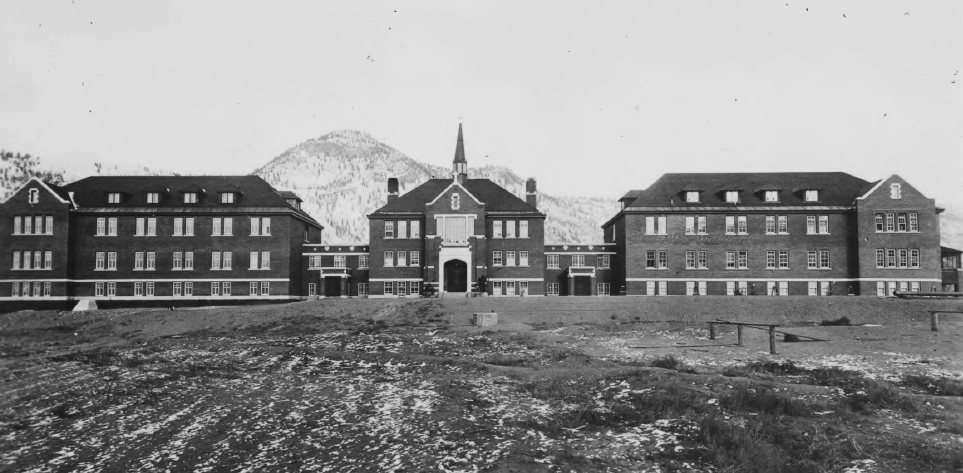Indian Residential Schools

Residential Schools in Canada
Between the late 1800s and 1996, the Government of Canada and church organizations operated the Indian Residential School System. An estimated 150,000 First Nations, Métis, and Inuit children were systematically removed from their families, homes, languages and lands. These schools were part of Canada’s official policy which aimed to eliminate Indigenous cultures and through assimilation cause Indigenous Peoples to cease to exist.
“Indian culture was a contradiction in terms, Indians were uncivilized, and the aim of education must be to destroy the Indian”
~ Davin, N. F. (1879). Report on Industrial Schools For Indians and Half-Breeds.
The schools were routinely overcrowded, underfunded, and rife with disease. Many children, weakened by malnutrition, did not survive. Mortality rates in some schools at times exceeded 60%. The system became notorious for high rates of mental, emotional, physical, spiritual and sexual abuse, and these abusive tactics were used against Indigenous children to intimidate them, prevent them from speaking their languages or practicing their cultures. These conditions and the abuses happening within the schools were documented at various times in government reports (e.g., the 1907 Bryce report), yet no action was taken by the Canadian government or church organizations.
It is estimated that between four to six thousand children died at residential schools.
The direct and indirect impacts of the abuse and violence that took place at residential schools continue to be felt today by Survivors, their families, and all Indigenous peoples in Canada.
“I want to get rid of the Indian problem.… Our objective is to continue until there is not a single Indian in Canada that has not been absorbed into the body politic and there is no Indian question, and no Indian Department, that is the whole object of this Bill.”
~ Scott, Dr. D. C. (1920). Department of Indian Affairs, 1913 – 1932
The last residential school in Canada closed in
1996
The number of Indigenous children that died in residential schools is estimated to be between
4000-6000
Across Canada, the number of residential schools totalled over
130+
Residential schools in BC
In British Columbia, there were 18 Federal-Church operated residential schools identified as part of the residential school settlement agreement: Ahousaht, Alberni, Cariboo, Christie, Coqualeetza, Cranbrook, Kamloops, Kitimaat, Kuper Island, Lejac, Lower Post, Port Simpson, Lytton, Mission, Alert Bay, Sechelt, Squamish (St. Paul’s) and Anahim Lake.
The first school opened in Mission, BC (St. Mary’s) in 1867 and was the final school to close in BC in 1984.
In addition to residential schools, BC also co-administered more than 100 Federal day schools and three large Indian hospitals in Prince Rupert (Miller Bay), Nanaimo and Sardis (Coqualeetza). Children from British Columbia were also taken out of the province to attend residential schools. The Aboriginal Healing Foundation estimates that the percentage of Indigenous children attending residential schools in BC was higher than in other places in Canada. In 2006, there were over 14,000 residential school Survivors still living in BC.
The stories from the survivors proved to be horrendous. One of the most common stories that we heard were from survivors who talked about the children who died in the schools and whose deaths they witnessed. Just as often, we heard about the loneliness and separation from their family — how they lost so much.
Kamloops Residential School
The Catholic-run Kamloops school became one of the largest schools in the residential school system, with more than 500 students enrolled in the early 1950s. In late May 2021, a devastating discovery of the remains of 215 children was made at the former Kamloops Residential School. The discovery prompted national and international calls to action for the Canadian government to take accountability for the suffering that Indigenous children, families and people have endured, and continue to endure.

Browse the records and collections
In-person visitors may engage with records through interactive technology at the Centre. The records can also be accessed at any time online.
Research support is available for Survivors and their families looking for personal records.
More Resources
- Bryce, P.H. (1922). “The story of a national crime: being an appeal for justice to the Indians of Canada.” Retrieved from https://collections.irshdc.ubc.ca/index.php/Detail/objects/9434
- Miller, J.R. (2020). “Residential Schools in Canada.” The Canadian Encyclopedia.
- Scott, Duncan Campbell. National Archives of Canada, Record Group 10, volume 6810, file 470-2-3, volume 7, pp. 55 (L-3) and 63 (N-3).
- Mosby, Ian. “Administering Colonial Science: Nutrition Research and Human Biomedical Experimentation in Aboriginal Communities and Residential Schools, 1942–1952.” Histoire sociale/Social history, vol. 46 no. 1, 2013, pp. 145-172. Project MUSE.
- “Misconceptions of Canada’s Indian Residential School System.” (2012). Aboriginal Healing Foundation. http://www.ahf.ca/downloads/misconceptions.pdf
- Indian Residential Schools & Reconciliation 11/12: Book 2. (2015). First Nations Education Steering Committee and First Nations Schools Association. http://www.fnesc.ca/wp/wp-content/uploads/2020/07/PUBLICATION-IRSR-12-pt-2-rev-2b-Full-Document-2020-07.pdf
- “100 Years of Loss” virtual exhibition. Retrieved from http://100yearsofloss.ca/en/
- “Where are the children” virtual exhibition. Retrieved from http://wherearethechildren.ca/en/about/
- “We were so far away” virtual exhibition. Retrieved from http://weweresofaraway.ca
- “Reclaiming Power and Place: The Final Report of the National Inquiry into Missing and Murdered Indigenous Women and Girls.” 2019. Retrieved from https://www.mmiwg-ffada.ca/final-report/
